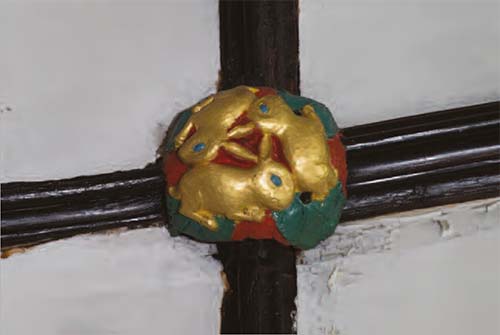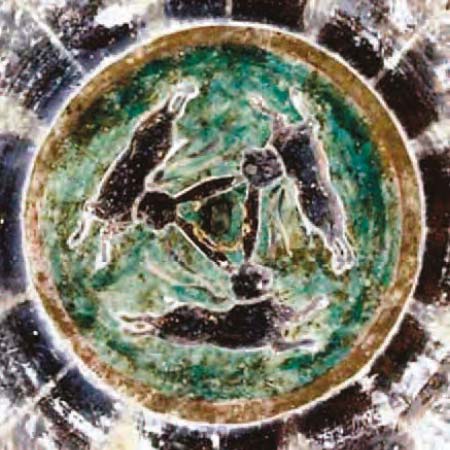1
The Nature of the Quest
Over the last twenty years there has been great interest in what is commonly known as the Three Hares symbol, where three hares gyrate round and round usually in a clockwise direction with conjoined ears. What is truly remarkable about the Three Hares symbol is the nature of its cultural and geographical diversity. This stretches from roof bosses in old medieval churches in Devon on the edge of Dartmoor as far east as the Buddhist caves of Dunhuang in western China, on the edge of the Gobi desert, a distance, of nearly six thousand miles, which, as the camel flies, is a very long way indeed. This route mirrors the Old Silk route with all its variations to Afghanistan and India. It can be followed like a very fine thread weaving its way between mountain ranges, across deserts and from time to time linking it with ancient cities and the odd oasis along the way. Also there is a long timeline that runs from approximately the 6th century AD up to the present day. The date of the real origin of the three hares symbol may of course be much earlier still.
On the Silk Road apart from the long suffering camels, there were horses, yaks and pack mules. These animals had a very hard job particularly at high altitude crossing mountain passes and traipsing across dry barren deserts, but these beasts of burden were essential for the heavily laden caravans. And of course they were led by their devoted handlers and caravan leaders, caravanserai owners, cooks, chai wallahs, dobhi wallas and temporary wives shacked up along the way. These traders were Buddhists, Armenians, Chinese, Persians, Indians, Ladakhis, Tibetans, Bactrians and Sogdians, Yarkandis, Khotanese and Kashgaris. Even Greeks, Romans and Arabs tried their hand. And many Greek and Roman artefacts ended up in Afghanistan. Despite the distances it was all very cosmopolitan and there were strong cultural, economic and political links between the cities and countries involved.
For nearly two thousand years there flowed along this tenuous, lengthy and even fragile route, an extraordinarily rich trade, not only of dried goods and fruits, silks and carpets, dyes and textiles, perfumes, gold, silver and tea, apothecaries herbs and drugs, but also ideas, philosophies and religious concepts, as well as folklore and superstition. It is along this route that the Three Hares symbol must have travelled, possibly in both directions and at different times. It was an important corridor, as important as the worldwide web is today. Yet with all our technology and scientific understanding, we still do not know the true meaning of the symbol, not least because it occurs in many different cultures in many different settings.

Three Hares roof boss, Tavistock, Devon. Photo:© George Wright
What is also remarkable is that the Three and Four Hares symbol crops up in at least four major religions: Christian, Buddhist, Islamic and Judaic contexts as well as in two locations within a Hindu Maharajah’s pleasure palace in Rajasthan. This alone makes the symbol fascinating. The Three Hares symbol appears in roof bosses in Christian churches, often alongside ‘Green Men’; it also appears in the centre section on the ceilings of many Buddhist caves in Dunhuang and on important robes on Buddhas in Tibetan Buddhist monasteries in Ladakh.
The cultural significance of the symbol may have varied in certain countries but the symbol with three conjoined ears remains remarkably intact. There may be four hares at some points, and the hares may be called rabbits, and sometimes they may look more like deer but they all have conjoined ears and go round in circles, some clockwise, some anticlockwise. It is a symbol, always intriguing and always on the move.

Three hares from Dunhuang Mogao Cave 407, Sui dynasty (581–618)
In Devon, for instance, there is a significant cluster on the edge of Dartmoor. The Three Hares symbol occurs twenty-nine times in seventeen churches. But it also crops up in other parts of Britain: in Long Melford in Suffolk, Chester, Selby, Corfe Mullen in Dorset, Old Cleeve in Somerset, Long Crendon in Buckinghamshire as well as St Davids in Pembrokeshire. There is even one in Cornwall in a chapel just on the other side of the Tamar at Cotehele. The Three Hares also occur in clusters in France and Germany. Then again in Sicily, Egypt, Iran, Kuwait, Ukraine, Afghanistan, Turkmenistan, Swat and Ladakh. The symbol occurs in roof bosses, on coins, on textiles, on trays, on floor tiles and carpets, inside Maitreya temples and chortens, on gravestones, on ceilings, on bells, in silver caskets from South Russia, on coins from the Mongol Horde, in learned books and psalters, in illuminated manuscripts and bestiaries. The symbol occurs in stone and wood, glass, on paper and vellum, the symbol is often linked to the moon, to Easter and the Second Coming. So the Three Hares are deeply embedded in folklore and antiquity. Yet no one can be certain of the reason for their existence or the meaning of their symbolism, although there are many interpretations, particularly in Ladakh where the Buddhist culture is still intact and flourishing.
As to meaning, one needs to absorb the Three Hares symbol on many different levels, as if it was part of an intellectual journey, a quest in the true medieval religious sense, a pilgrimage and an entertaining diversion from daily life. It has all the makings not just of a good story but of an inner journey as well as a modern pilgrimage. As with any good hunt or chase or quest, the senses are often heightened and the discovery of yet more clues along the way is enticing. It is after all something of a puzzle, a treasure hunt, and the quest similar to that undertaken by a medieval knight to accomplish a prescribed task.Yet within the quest is a spiritual, if not sacred element, not least because many of the settings are often churches, chapels, caves or monastic temples, including the occasional synagogue. The best way to approach the Three Hares, I found, is as if it is a riddle, like a Chinese or Japanese koan, like chasing the answer to an unanswerable question, which makes it indeed a ‘curiosity worth regarding’. A typical English understatement to major philosophical questions. So to proceed to the quest – and this book is only a guide, a finger pointing out into space – devotees of the hare need an enquiring mind, a passport and the concept of pilgrimage, for it is indeed puzzling, a sacred mystery. Make of it what you will. If your mind is fertile then the hares will work their magic, not only in your waking moments but in your dreams as well. Carl Jung was intrigued by the Three Hares, which would have had Freud going round in circles.